
Ready 2 Rumble Boxing is a boxing video game developed by Midway Studios San Diego, and published by Midway in 1999 for the Dreamcast, PlayStation, Game Boy Color, and Nintendo 64. The success of the Dreamcast version led to it becoming one of the few Sega All Stars titles.

WWF WrestleMania 2000 is a professional wrestling video game released in 1999 on the Nintendo 64 (N64) console. It was based on the World Wrestling Federation's annual pay-per-view, WrestleMania. Despite the fact that this game is based upon WrestleMania 2000, the game was released five months prior to the actual PPV itself, therefore resulting in the game using the stage design from the 1999 event, WrestleMania XV, instead. Released at the height of the WWF's Attitude Era, WrestleMania 2000 was the first WWF game released by THQ. The wrestling company ended its long relationship with Acclaim Entertainment after witnessing the video game success of its competitor, World Championship Wrestling (WCW), on behalf of THQ. WrestleMania 2000 shares its game engine with the Japan-only release Virtual Pro Wrestling 2: Ōdō Keishō.

WWF No Mercy is a professional wrestling video game released in 2000 by THQ for the Nintendo 64. It is based on the World Wrestling Federation and is named after the company's annual event of the same name. Developed by Asmik Ace Entertainment and AKI Corporation, No Mercy is the last in a series of Nintendo 64 wrestling games from the companies that started with WCW vs. nWo: World Tour.
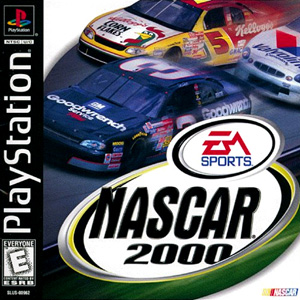
NASCAR 2000 is a racing simulator video game developed by Stormfront Studios and published by EA Sports.

Vigilante 8 is a vehicular combat video game developed by Luxoflux and published by Activision for PlayStation, Nintendo 64, and Game Boy Color. Although officially it has no connection to the Interstate '76 series, it features several of its themes.

Madden NFL 2000 is a football video game. This was the second of the Madden NFL games to not solely feature John Madden on the cover in North America. The only other one was Madden NFL '95. Most versions of the game cover featured Madden prominently in the foreground, and a recognizable Barry Sanders in a background action graphic. The European PAL edition features only Dorsey Levens on the cover.
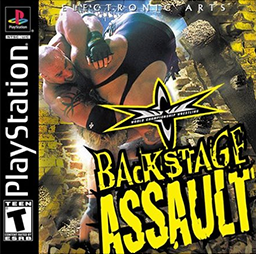
WCW Backstage Assault is a professional wrestling video game developed by Kodiak Interactive and published by Electronic Arts. It was released for the PlayStation in November 2000, and for the Nintendo 64 in December. It was the final World Championship Wrestling (WCW) game released before the World Wrestling Federation (WWF) purchased the company's assets three months later. Backstage Assault features commentary by Tony Schiavone and Bobby "The Brain" Heenan. The game is distinguished by the fact that all gameplay takes place outside of a standard wrestling ring, an approach that was poorly received, and resulted in the title selling 200,000 copies.

WWF War Zone is a professional wrestling video game developed by Iguana West and released by Acclaim Entertainment in 1998 for the PlayStation, Nintendo 64, and Game Boy. The game features wrestlers from the World Wrestling Federation.

WWF Attitude is a professional wrestling video game based on the World Wrestling Federation released by Acclaim Entertainment in 1999 for the PlayStation and Nintendo 64. A slightly enhanced port of the game was later released for the Dreamcast, as well as a handheld version for the Game Boy Color. The game is named after the WWF's then-current "Attitude" marketing campaign, with the tagline "Get it" also being used on company programming during that period.

ECW Hardcore Revolution is a professional wrestling video game released by Acclaim Entertainment, based on the professional wrestling promotion Extreme Championship Wrestling (ECW). The game was released for the Nintendo 64, PlayStation, Game Boy Color, and Dreamcast in 2000. It was the first wrestling game to be based on ECW, as well as the first professional wrestling video game to receive a Mature rating from the ESRB, although the Game Boy Color version was rated Everyone. Acclaim followed this title with the release of a sequel, ECW Anarchy Rulz, in August 2000.

Armorines: Project S.W.A.R.M., known as Armorines in Europe, is a 1999 first-person shooter developed by Acclaim Studios London and released for the Nintendo 64, Game Boy Color and PlayStation. It is based on the Armorines comic book from Valiant Comics, which was bought by Acclaim Entertainment.

NBA In The Zone '99, known in Europe as NBA Pro 99, is a basketball game for the Nintendo 64 and PlayStation, released in 1999. It is the fourth installment of the NBA In The Zone series. The game has two covers of NBA All-Star Glen Rice,.
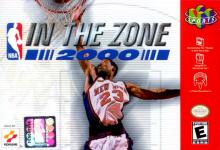
NBA In The Zone 2000 is a basketball video game released for the Nintendo 64, PlayStation, and Game Boy Color in 2000. It is the fifth and final installment of the NBA In The Zone series. The cover features Marcus Camby of the New York Knicks.

Polaris SnoCross is a snocross snowmobile racing game for Game Boy Color, PlayStation, Nintendo 64, and later Microsoft Windows. It was released in 2000. French publisher Wanadoo Edition released a budget version of the game for the PC in 2001, called SnowCross.
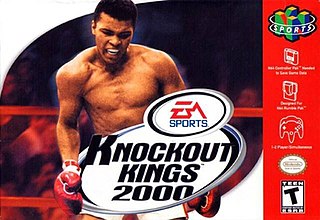
Knockout Kings 2000 is a video game developed by Black Ops Entertainment and published by EA Sports for Nintendo 64, PlayStation, and Game Boy Color in 1999.
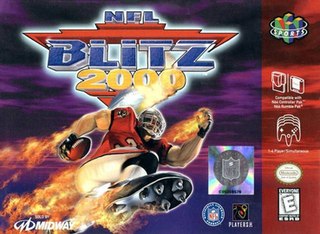
NFL Blitz 2000 is a video game released in the arcades in 1999 and then ported to the PlayStation, Nintendo 64, Dreamcast, Microsoft Windows, and Game Boy Color. It is the third game in the NFL Blitz series.
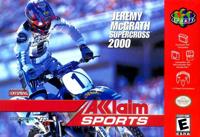
Jeremy McGrath Supercross 2000 is a motocross racing video game developed by Acclaim Studios Salt Lake City and published by Acclaim Entertainment under their Acclaim Sports label for Nintendo 64, Game Boy Color, PlayStation and Dreamcast. It features eight stadium tracks, eight outdoor tracks, and an option for players to create their own custom tracks. In addition to having a racing game mode, players could perform dirt bike tricks in a stunt mode.

Army Men: Air Attack is a third-person shooter video game developed and published by The 3DO Company for PlayStation, Nintendo 64, Game Boy Color and Microsoft Windows. The game focuses on aerial combat and features the same protagonist, Cpt. William Blade. It is one of the first Army Men games to be powered by a 3D engine where terrain and units are rendered in real-time.

NFL Blitz 2001 is a video game developed and published by Midway for the Dreamcast, PlayStation, Nintendo 64 and Game Boy Color in 2000.

NFL Blitz is an American football video game developed and published by Midway for the arcade in 1997, the first game in the NFL Blitz series. The development team was headed by Mark Turmell and Sal Divita, who were known for being behind NBA Jam, and NFL Blitz was a deliberate attempt to translate the exaggerated arcade-style approach of NBA Jam to the football realm. The game was ported to the PlayStation, Nintendo 64, Windows, and Game Boy Color in 1998. The cover athlete for the game was then Pittsburgh Steelers quarterback Kordell Stewart.




















